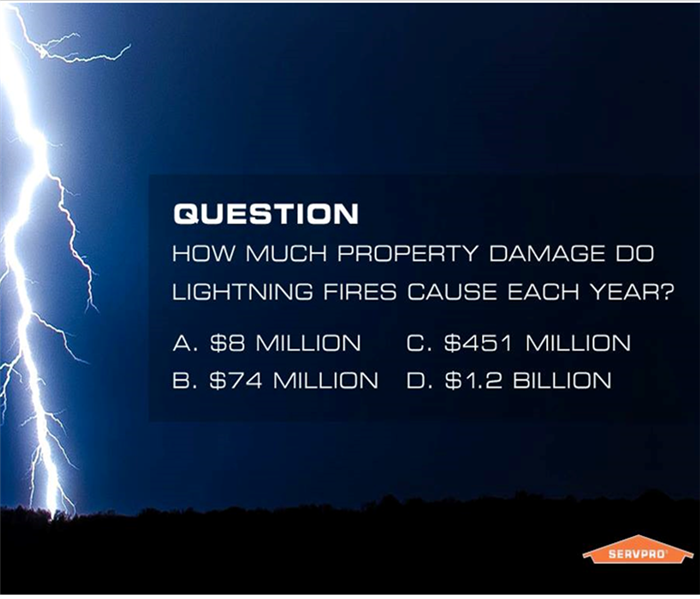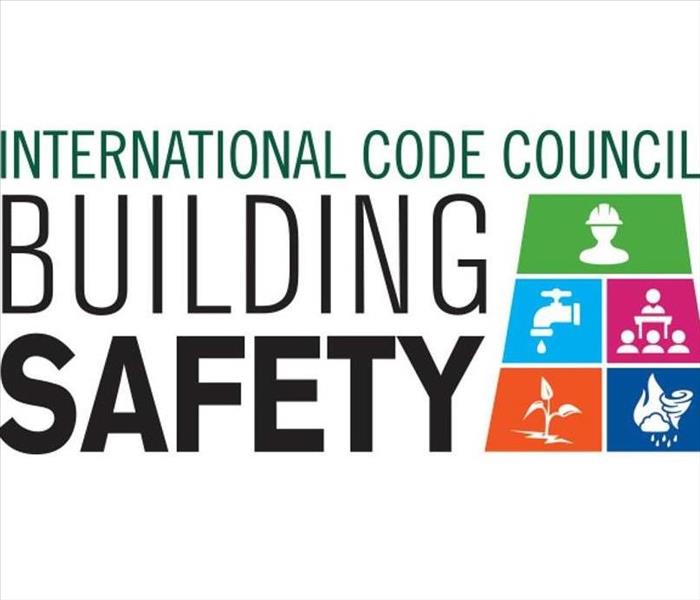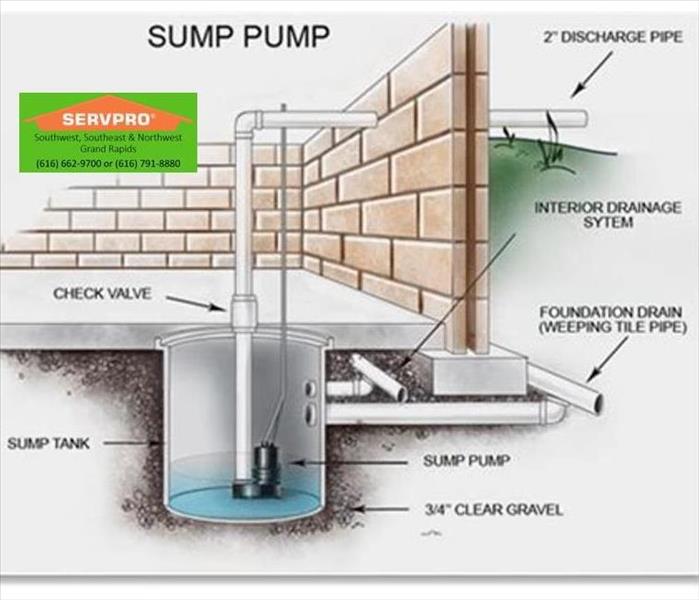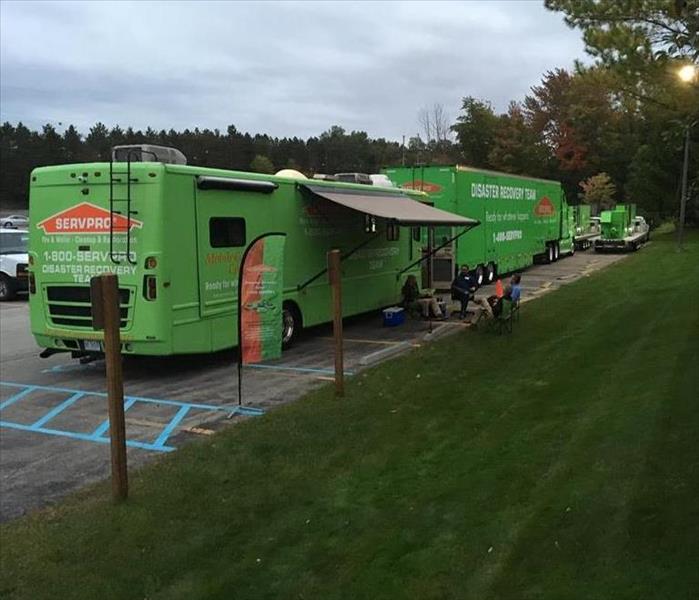Recent Storm Damage Posts
Board-ups after a storm can be difficult
5/24/2018 (Permalink)
 Boarding a building after a storm can be dangerous, leave it to the professionals.
Boarding a building after a storm can be dangerous, leave it to the professionals.
Southeast Grand Rapids Leave the Hassle of Board-Ups to the Professionals
Why take the risk? Call SERVPRO® of Southeast Grand Rapids.
Whether after a fire, storm, or other structural disaster, boarding up damaged property is a burden that no one should ever have to go through—especially if it is your property that has been damaged.
Boarding up damaged property incorrectly could cause secondary damages such as moisture or animal intrusion, making the situation even worse. The process of boarding up after an unexpected damage can also be as dangerous as the damage itself.
SERVPRO® of Southeast Grand Rapids can board up the damaged property and mitigate and remediate the original damage, providing you with peace of mind while helping make it
“Like it never even happened.” Contact us at 616-977-9800 for 24/7 emergency service.
Be prepared for a Storm
5/24/2018 (Permalink)
 Thunder and Lightning storms cause damage you not be prepared for.
Thunder and Lightning storms cause damage you not be prepared for.
Southeast Grand Rapids, To prepare for a thunderstorm, you should do the following:
- To begin preparing, you should build an emergency kit and make a family communications plan.
- Remove dead or rotting trees and branches that could fall and cause injury or damage during a severe thunderstorm.
- Postpone outdoor activities.
- Secure outdoor objects that could blow away or cause damage.
- Get inside a home, building, or hard top automobile (not a convertible). Although you may be injured if lightning strikes your car, you are much safer inside a vehicle than outside.
- Remember, rubber-soled shoes and rubber tires provide NO protection from lightning. However, the steel frame of a hard-topped vehicle provides increased protection if you are not touching metal.
- Shutter windows and secure outside doors. If shutters are not available, close window blinds, shades or curtains.
- Unplug any electronic equipment well before the storm arrives.
Know the Terms
Familiarize yourself with these terms to help identify a thunderstorm hazard:
Severe Thunderstorm Watch- Tells you when and where severe thunderstorms are likely to occur. Watch the sky and stay tuned to NOAA Weather Radio, commercial radio or television for information.
Severe Thunderstorm Warning- Issued when severe weather has been reported by spotters or indicated by radar. Warnings indicate imminent danger to life and property to those in the path of the storm.
Source ready.gov
If a Thunderstorm should hit your property and you need restoration services due to Storm Damage, Call SERVPRO® of Southeast Grand Rapids at 616-977-9800 24/7 emergency services available.
Building Safety awareness during a storm
5/24/2018 (Permalink)
 Building codes save lives during storms.
Building codes save lives during storms.
Building Safety Month, in its 38th year, is an initiative of the International Code Council (ICC) and their 64,000 members across the world, as well as their partners in building construction and design and the safety community. Building Safety Month is an opportunity to educate insurance and commercial property professionals, as well as the general public, on “what it takes to create safe, resilient, affordable, and energy efficient homes and buildings,” according to the ICC website.
The theme for 2018 is Building Codes Save Lives with a focus on safer communities over the five weeks in May.
One of the topics highlighted during the third week of the month is Protecting Communities from Disasters.
The general public may not be aware how codes and code officials “improve and protect the places where we live, learn, work, worship, and play,” and this month can certainly improve that awareness and educate communities on this topic!
IMPORTANT TIPS FROM THE ICC
Disaster Safety & Mitigation
- If you live in a high wind or hurricane-prone area and do not have tested and code-approved shutters for protection from windborne debris, consider temporarily protecting your doors and windows by mounting exterior grade, 7/16" minimum thickness plywood and fastening it into place. Visit www.flash.org for detailed instructions on how to use plywood for emergency board-up.
- Consider building or retrofitting to create a tornado-safe room in your home. Follow ICC/ NSSA 500 Standard for detailed construction information and to ensure you achieve the highest level of protection for your family.
- In wildfire prone areas, remove fine (dead grass, leaves, etc.) and coarse (dead twigs, branches, etc.) fuels within 30 feet of a building to create a survivable space in case of wildfire. Be sure to remove dry leaf and pine litter from roofs, rain gutters, decks, and walkways. Follow ICC’s International Wildland-Urban Interface Code® for detailed requirements.
- Flooded roads could have significant damage hidden by floodwaters. Never drive through floodwaters or on flooded roads. Do not attempt to cross a flowing stream. It takes only six inches of fast flowing water to sweep you off your feet and two feet of water to move an SUV-sized vehicle.
- Source: iccsafe.org
If a disaster hits your home Contact SERVPRO® of Southeast Grand Rapids at 616-977-9800, available 24/7 for emergency services.
Lightning Dangers
5/24/2018 (Permalink)
 WOW $451 Million!!! Are you covered for storm damage?
WOW $451 Million!!! Are you covered for storm damage?
Lightning can cause fire
What do you do when Lightning strikes? Do you hide or sit and watch the beauty? Whatever you do, make sure you keep an eye out for the dangers it can cause.
Facts about Lightning
- Lightning’s unpredictability increases the risk to individuals and property.
- Lightning often strikes outside of heavy rain and may occur as far as 10 miles away from any rainfall.
- “Heat lightning” is actually lightning from a thunderstorm too far away from thunder to be heard. However, the storm may be moving in your direction.
- Most lightning deaths and injuries occur when people are caught outdoors in the summer months during the afternoon and evening.
- Your chances of being struck by lightning are estimated to be 1 in 600,000 but could be reduced even further by following safety precautions.
- Lightning strike victims carry no electrical charge and should be attended to immediately.
If a Lightning should hit your property and you need restoration services due to Storm Damage, Call SERVPRO® of Southeast Grand Rapids at 616-977-9800 24/7 emergency services available.
Sump Pump Failures
3/30/2018 (Permalink)
 How sump pump works.
How sump pump works.
When the ground is dry and then gets an influx of water to saturate the ground, where does the water go? Once the water has flooded the surrounding grounds, the water searches for the weakest point to enter any hard surfaces. Many times that is your basement floor. Which is why we have sump pumps.
How it works - A hole is dug in the lowest part of your basement or crawlspace where a sump pump sits and filters out water. As the pit fills up, the pump turns on and moves the liquid out of the pit through pipes that run away from the foundation of your home into an area where it can drain, such as a municipal storm drain or a dry well. A one-way valve (check valve) keeps water from entering back into the home.
Why does it fail?
- Power Failure
- Pump is the wrong Size
- Improper Installation
- Switch Problems on the pump
- Lack of Maintenance
- Frozen or Clogged Discharge Lines
- Product Default
- Passed Life Expectancy
How can you prevent failure? Quarterly maintenance.
When there’s an influx of ground water or your power goes out, keep an eye on your pump to make sure you don’t become a victim of a flooded area in your home.
Another important point is the sump pump's power supply. The fact that sump pumps rely on electricity to operate does make them vulnerable in the event of a power outage. Fortunately, there are backup options available. For some people, at least those on municipal water systems -- and assuming the city water system is still functional -- water-powered sump pumps that don't need any electricity are an option. These pumps literally use the pressure of flowing water to pump water out of the sump. The downside to this design is that the pumping process uses virtually the same amount of city water as the quantity of water it pumps out. So, while water-powered pumps aren't necessarily a good choice for a main pump, they offer a viable option for a short duration backup pump.
SERVPRO® of Southeast Grand Rapids is here to help. We are available 24/7 for emergency services. Call us at 616-977-9800
Be prepared for natural disasters
3/9/2018 (Permalink)
 Have a kit and plan together for when the big storm hits!
Have a kit and plan together for when the big storm hits!
Don’t wait to prepare!! Emergencies can happen unexpectedly in communities just like yours, to people just like you. Tornado outbreaks, river floods, flash floods, historic earthquakes, and even water main breaks and power outages in U.S. cities affecting millions of people for days at a time.
Now is the time to think about the basics, things you will need in advance of an emergency; how you will communicate, what supplies you will need to keep in your home, car or office. Use the list provided here to build an emergency supply kit to ensure your family is equipped and ready for any type of disaster.
The more you know about what to do in an emergency, the more confident and secure you will feel in your abilities to manage through a disaster.
Preparation is the key to making it through any size disaster, whether it is a small water leak, a large fire, or an area flood. The best time to plan for such events is not when the event happens, but well before it happens. No one ever plans on a disaster, but now, you can plan for it.
Build An Emergency Supply Kit:
- Water, gallon per person per day
- Food, non-perishable 3-day supply
- Manual can opener
- Battery operated radio and extra batteries
- Flashlight and extra batteries
- First aid kit
- Whistle to signal for help
- Wrench or pliers to turn off utilities, if necessary
- Dust masks or bandanas
- Plastic sheeting, garbage bags and duct tape
- Local maps
- Hygiene items
- Clothing
- Fire extinguisher
- Matches in waterproof container
- Cash
- Important documents such as:
- Copies of insurance
- Policies, identification and
- Bank account information
Contact SERVPRO® Southeast Grand Rapids Professionals for more information and tools to help you be “Ready for whatever happens.”
Southeast Grand Rapids Leave the Hassle of Board-Ups to the Professionals
5/25/2017 (Permalink)
 Boarded up apartment after a fire.
Boarded up apartment after a fire.
Why take the risk? Call SERVPRO of Southeast Grand Rapids.
Whether after a fire, storm, or other structural disaster, boarding up damaged property is a burden that no one should ever have to go through—especially if it is your property that has been damaged.
Boarding up damaged property incorrectly could cause secondary damages such as moisture or animal intrusion, making the situation even worse. The process of boarding up after an unexpected damage can also be as dangerous as the damage itself.
SERVPRO of Southeast Grand Rapids can board up the damaged property and mitigate and remediate the original damage, providing you with peace of mind while helping make it
“Like it never even happened.” Contact us at 616-977-9800 for 24/7 emergency service.
MAY IS NATIONAL BUILDING SAFETY MONTH
5/25/2017 (Permalink)
Building Safety Month— in its 37th year—is an initiative of the International Code Council (ICC) and their 57,000 member’s across the world, as well as their partners in building construction and design, and the safety community. Building Safety Month is an opportunity to educate insurance and commercial property professionals, as well as the general public, on “what it takes to create safe, resilient, affordable, and energy efficient homes and buildings,” according to the ICC website.
The theme for 2017 is Code Officials— Partners in Community Safety and Economic Growth and highlights managing disasters, specifically natural disasters, in week three of this year’s campaign.
Some of the topics and tips shared throughout the month include Disaster Safety and Mitigation, as well as Fire Safety and Awareness.
The general public may not be aware how codes and code officials “improve and protect the places where we live, learn, work, worship, and play,” and this month can certainly improve that awareness!
IMPORTANT TIPS FROM THE ICC Disaster Safety & Mitigation
- If you live in a high wind or hurricane prone area and do not have tested and code-approved shutters for protection from windborne debris, consider temporarily protecting your doors and windows by mounting exterior grade, 7/16" minimum thickness plywood and fastening it into place. Visit www.flash.org for detailed instructions on how to use plywood for emergency board-up.
- Consider building or retrofitting to create a tornado-safe room in your home. Follow ICC/ NSSA 500 Standard for detailed construction information and to ensure you achieve the highest level of protection for your family.
- In wildfire prone areas, remove fine (dead grass, leaves, etc.) and coarse fuels (dead twigs, branches, etc.) within 30 feet of a building to create a survivable space in case of wildfire. Be sure to remove dry leaf and pine litter from roofs, rain gutters, decks, and walkways. Follow ICC’s International Wildland-Urban Interface Code® for detailed requirements.
- Flooded roads could have significant damage hidden by floodwaters. Never drive through floodwaters or on flooded roads. Do not attempt to cross a flowing stream. It takes only six inches of fast flowing water to sweep you off your feet and two feet of water to move an SUV-sized vehicle.
- Source: iccsafe.org.
If a disaster hits your home Contact SERVPRO of Southeast Grand Rapids at 616-977-9800, available 24/7 for emergency services
Southeast Grand Rapids, To prepare for a thunderstorm, you should do the following:
5/25/2017 (Permalink)
To prepare for a thunderstorm, you should do the following:
- To begin preparing, you should build an emergency kit and make a family communications plan.
- Remove dead or rotting trees and branches that could fall and cause injury or damage during a severe thunderstorm.
- Postpone outdoor activities.
- Secure outdoor objects that could blow away or cause damage.
- Get inside a home, building, or hard top automobile (not a convertible). Although you may be injured if lightning strikes your car, you are much safer inside a vehicle than outside.
- Remember, rubber-soled shoes and rubber tires provide NO protection from lightning. However, the steel frame of a hard-topped vehicle provides increased protection if you are not touching metal.
- Shutter windows and secure outside doors. If shutters are not available, close window blinds, shades or curtains.
- Unplug any electronic equipment well before the storm arrives.
Lightning Risk Reduction When Outdoors
If you are: In a forest Then: Seek shelter in a low area under a thick growth of small trees.
If you are: In an open area Then: Go to a low place such as a ravine or valley. Be alert for flash floods.
If you are: On open water Then: Get to land and find shelter immediately.
Facts about Thunderstorms
- They may occur singly, in clusters or in lines.
- Some of the most severe occur when a single thunderstorm affects one location for an extended time.
- Thunderstorms typically produce heavy rain for a brief period, anywhere from 30 minutes to an hour.
- Warm, humid conditions are highly favorable for thunderstorm development.
- About 10 percent of thunderstorms are classified as severe – one that produces hail at least an inch or larger in diameter, has winds of 58 miles per hour or higher or produces a tornado.
Facts about Lightning
- Lightning’s unpredictability increases the risk to individuals and property.
- Lightning often strikes outside of heavy rain and may occur as far as 10 miles away from any rainfall.
- “Heat lightning” is actually lightning from a thunderstorm too far away from thunder to be heard. However, the storm may be moving in your direction.
- Most lightning deaths and injuries occur when people are caught outdoors in the summer months during the afternoon and evening.
- Your chances of being struck by lightning are estimated to be 1 in 600,000 but could be reduced even further by following safety precautions.
- Lightning strike victims carry no electrical charge and should be attended to immediately.
Know the Terms
Familiarize yourself with these terms to help identify a thunderstorm hazard:
Severe Thunderstorm Watch- Tells you when and where severe thunderstorms are likely to occur. Watch the sky and stay tuned to NOAA Weather Radio, commercial radio or television for information.
Severe Thunderstorm Warning- Issued when severe weather has been reported by spotters or indicated by radar. Warnings indicate imminent danger to life and property to those in the path of the storm.
Source ready.gov
If a Thunderstorm should hit your property and you need restoration services due to Storm Damage, Call SERVPRO of Southeast Grand Rapids at 616-977-9800 24/7 emergency services available.
When Tornadoes cause damage to your Southeast Grand Rapids property
5/25/2017 (Permalink)
Tornadoes are nature’s most violent storms. Spawned from powerful thunderstorms, tornadoes can cause fatalities and devastate a neighborhood in seconds. A tornado appears as a rotating, funnel-shaped cloud that extends from a thunderstorm to the ground with whirling winds that can reach 300 miles per hour. Damage paths can be in excess of one mile wide and 50 miles long. Every state is at some risk from this hazard. Some tornadoes are clearly visible, while rain or nearby low-hanging clouds obscure others. Occasionally, tornadoes develop so rapidly that little, if any, advance warning is possible. Before a tornado hits, the wind may die down and the air may become very still. A cloud of debris can mark the location of a tornado even if a funnel is not visible. Tornadoes generally occur near the trailing edge of a thunderstorm. It is not uncommon to see clear, sunlit skies behind a tornado
After A Tornado
- Listen to local officials for updates and instructions.
- Check-in with family and friends by texting or using social media.
- Watch out for debris and downed power lines.
- If you are trapped, do not move about or kick up dust. Tap on a pipe or wall or use a whistle, if you have one, so that rescuers can locate you.
- Stay out of damaged buildings and homes until local authorities indicate it is safe.
- Photograph the damage to your property in order to assist in filing an insurance claim.
- Do what you can to prevent further damage to your property, (e.g., putting a tarp on a damaged roof), as insurance may not cover additional damage that occurs after the storm.
- If your home is without power, use flashlights or battery-powered lanterns rather than candles to prevent accidental fires.
Source ready.gov
If a Tornado should hit your property and you need restoration services due to Storm Damage, Call SERVPRO of Southeast Grand Rapids at 616-977-9800 24/7 emergency services available.
Do you have an Emergency Communication Plan for when disaster strikes?
5/25/2017 (Permalink)
The following explains what an emergency communication plan is and why you should make one. It also provides tips and templates on how to make a plan. The following information is from ready.gov.
Your family may not be together if a disaster strikes, so it is important to think about the following situations and plan just in case. Consider the following questions when making a plan:
- How will my family/household get emergency alerts and warnings?
- How will my family/household get to safe locations for relevant emergencies?
- How will my family/household get in touch if cell phone, internet, or landline doesn’t work?
- How will I let loved ones know I am safe?
- How will family/household get to a meeting place after the emergency?
Here are a few easy steps to start your emergency communication plan:
- Understand how to receive emergency alerts and warnings. Make sure all household members are able to get alerts about an emergency from local officials. Check with your local emergency management agency to see what is available in your area, and learn more about alerts by visiting: ready.gov/alerts.
- Discuss family/household plans for disasters that may affect your area and plan where to go. Plan together in advance so that everyone in the household understands where to go during a different type of disaster like a hurricane, tornado, or wildfire.
- Collect information. Create a paper copy of the contact information for your family that includes:
- phone (work, cell, office)
- email
- social media
- medical facilities, doctors, service providers
- school
- Identify information and pick an emergency meeting place. Things to consider:
- Decide on safe, familiar places where your family can go for protection or to reunite.
- Make sure these locations are accessible for household members with disabilities or access and functional needs.
- If you have pets or service animals, think about animal-friendly locations.
Examples of meeting places:
- In your neighborhood: A mailbox at the end of the driveway, or a neighbor’s house.
- Outside of your neighborhood: library, community center, place of worship, or family friend’s home.
- Outside of your town or city: home of a relative or family friend. Make sure everyone knows the address of the meeting place and discuss ways you would get there.
- Share information. Make sure everyone carries a copy in his or her backpack, purse, or wallet. You should also post a copy in a central location in your home, such as your refrigerator or family bulletin board.
- Practice your plan.Have regular household meetings to review your emergency plans, communication plans and meeting place after a disaster, and then practice, just like you would a fire drill.
Source ready.gov
When disaster hits your property and you need restoration services due to Storm Damage, Call SERVPRO of Southeast Grand Rapids at 616-977-9800 24/7 emergency services available.
When Storms or Floods hit Southeast Grand Rapids, SERVPRO is ready!
4/10/2017 (Permalink)
 Our highly trained crews are ready to respond 24/7 to storm or flood damage in Southeast Grand Rapids.
Our highly trained crews are ready to respond 24/7 to storm or flood damage in Southeast Grand Rapids.
SERVPRO of Southeast Grand Rapids specializes in storm and flood damage restoration. Our crews are highly trained and we use specialized equipment to restore your property to its pre-storm condition.
Faster Response
Since we are locally owned and operated, we are able to respond quicker with the right resources, which is extremely important. A fast response lessens the damage, limits further damage, and reduces the restoration cost.
Resources to Handle Floods and Storms
When storms hit Southeast Grand Rapids, we can scale our resources to handle a large storm or flooding disaster. We can access equipment and personnel from a network of 1,650 Franchises across the country and elite Disaster Recovery Teams that are strategically located throughout the United States.
Have Storm or Flood Damage? Call Us Today 616-977-9800






 24/7 Emergency Service
24/7 Emergency Service





